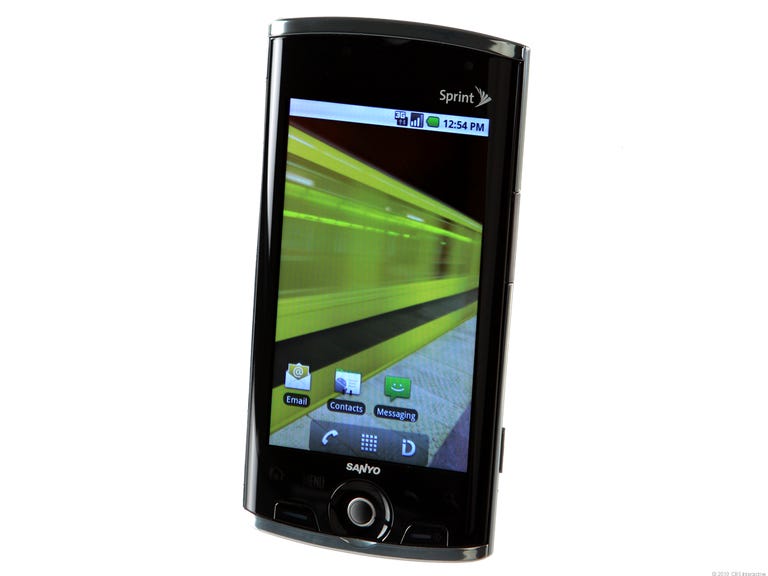 Why You Can Trust CNET
Why You Can Trust CNET Sanyo Zio SCP-8600 (Sprint) review: Sanyo Zio SCP-8600 (Sprint)
Sanyo Zio SCP-8600 (Sprint)
The Good
The Bad
The Bottom Line
Editors' note: Since Sprint's Sanyo Zio closely resembles Cricket Wireless's Zio, in this review we'll concentrate on the differences between the two devices. For a full description of the Zio's design and features, see our Sanyo Zio M6000 review.
No sooner did we review the Sanyo Zio for Cricket Wireless than Sprint decided to counter with its own version of the Android handset. On the whole, Sprint's Zio is largely similar to Cricket's Zio, though it shows a few unique hallmarks like the extra chrome around the edges and the inclusion of the carrier's new Sprint ID feature. Admittedly, those wouldn't be significant on their own, but the addition of Android OS 2.1 (Cricket's phone had 1.6) gives the Sprint Zio a solid boost over its competition. Here again, the Zio is made by Kyocera, though it's marketed under the Sanyo brand. Its price tag is a respectable $99 with a two-year contract and a $100 mail-in rebate. If you pay full price, it will cost you $349.
Design
As mentioned, the Sprint Zio is largely unchanged from the Cricket Wireless model. Its design is equally utilitarian, but we don't think that's a bad thing given the intuitive controls and touch screen. Speaking of which, the 3.5-inch WVGA display supports the same resolution (262,000 colors; 800x480 pixels) and the handset as a whole has identical measurements (4.6 inches long by 2.3 inches wide by 0.48 inch deep; it weighs 3.7 ounces).
Yet, the Sprint Zio has its own style. The Cricket handset was black all the way around, but this model shows chrome detailing around the edges. It's a welcome touch on an otherwise plain phone. Other exterior features include a 3.5mm headset jack, the volume rocker, and the Micro-USB charger port on the left spine. The MicroSD card slot sits conveniently on the right spine next to the camera shutter. You get a 2GB MicroSD card in the box.

Though the main menu, phone dialer, and virtual keyboard all have the standard Android design, the home screens are starkly different thanks to the Sprint ID feature. Along with the Samsung Transform and the LG Optimus S, the Zio is a debut device for Sprint ID, which offers users a deeper level of customization beyond the typical Android experience.

In short, the Sprint ID offers "ID packs" that you can change by pressing the designated touch control at the bottom of the display. Each ID pack contains a combination of wallpaper, widgets, home screen shortcut buttons, and apps that are bundled together to create a themed experience. As you switch between ID Packs, the home screen and other elements will change accordingly. The Zio will come with a selection of ID packs, but you can download more and create your own. For example, the Sprint ID Pack features yellow wallpaper and includes access to dedicated Sprint apps like Sprint Zone and Nascar Mobile.
Though Sprint ID is interesting and it allows the carrier to differentiate itself, I'm not a big fan. The whole experience feels forced and it appears to be another way for a carrier to repackage Android in a manner that goes against the operating system's open spirit. Also, I have to agree with Jessica Dolcourt's analysis in her Sprint ID review. Not only does she see it as an avenue to crapware, but she also worries that Sprint ID will result in stealth advertising.
Features
On the other hand, Sprint ID does bring the Zio SCP-8600 one big advantage: because the feature is compatible only with Android 2.1 and above, Sprint had to give the Zio a newer version of the OS. Though we'd prefer Android 2.2 out of the gate (the Zio will upgrade to Froyo in the future), we'll take 2.1 over the ancient OS 1.6 we had on Cricket's Zio. Benefits of Eclair include five home screens and notable interface improvements.

Other features are unchanged. Inside you'll find a personal organizer, a 3.2-megapixel camera with video recording, Bluetooth, Wi-Fi, a speakerphone, PC syncing, USB mass storage, a music player, GPS, voice commands, messaging and e-mail, access to the Android market, and the usual assortment of Android apps. On the downside, you don't get the File Browser app we had on the Cricket handset.

Performance
We tested the dual-band (CDMA 800/1900) Sanyo Zio in San Francisco using Sprint service. Call quality was quite good, with admirable clarity and little or no static or interference. We also enjoyed slightly louder volume than on the Cricket model, which is odd considering it's basically the same phone. The difference was minimal, but it was nonetheless noticeable.
On their end, callers said we sounded good. They could tell we were using a cell phone, but most of our friends had no complaints. A couple of people mentioned some static, but they added that it wasn't overwhelming. Also, as on the Cricket phone, we had to speak up if there was a lot of background noise, particularly if we were talking to an automated voice responsive system. Speakerphone calls were loud, but also a bit shrill on our end.
Data support tops out at Sprint's 3G EV-DO network, so don't count on any WiMax speeds on the Zio. Data speeds on this Zio were a tad slow overall--it took more than a minute to open busy sites like Giantbomb.com--but sites with fewer graphics will load more quickly. To save time, the Zio will default to the mobile version of a Web site if one is available.
The Zio has a rated battery life of 4.6 hours talk time, compared with a promised 6.9 hours on the Cricket phone. It has a tested talk time of 5 hours and 4 minutes. According to FCC radiation tests, the Zio has a digital SAR rating of 1.39 watts per kilogram.


